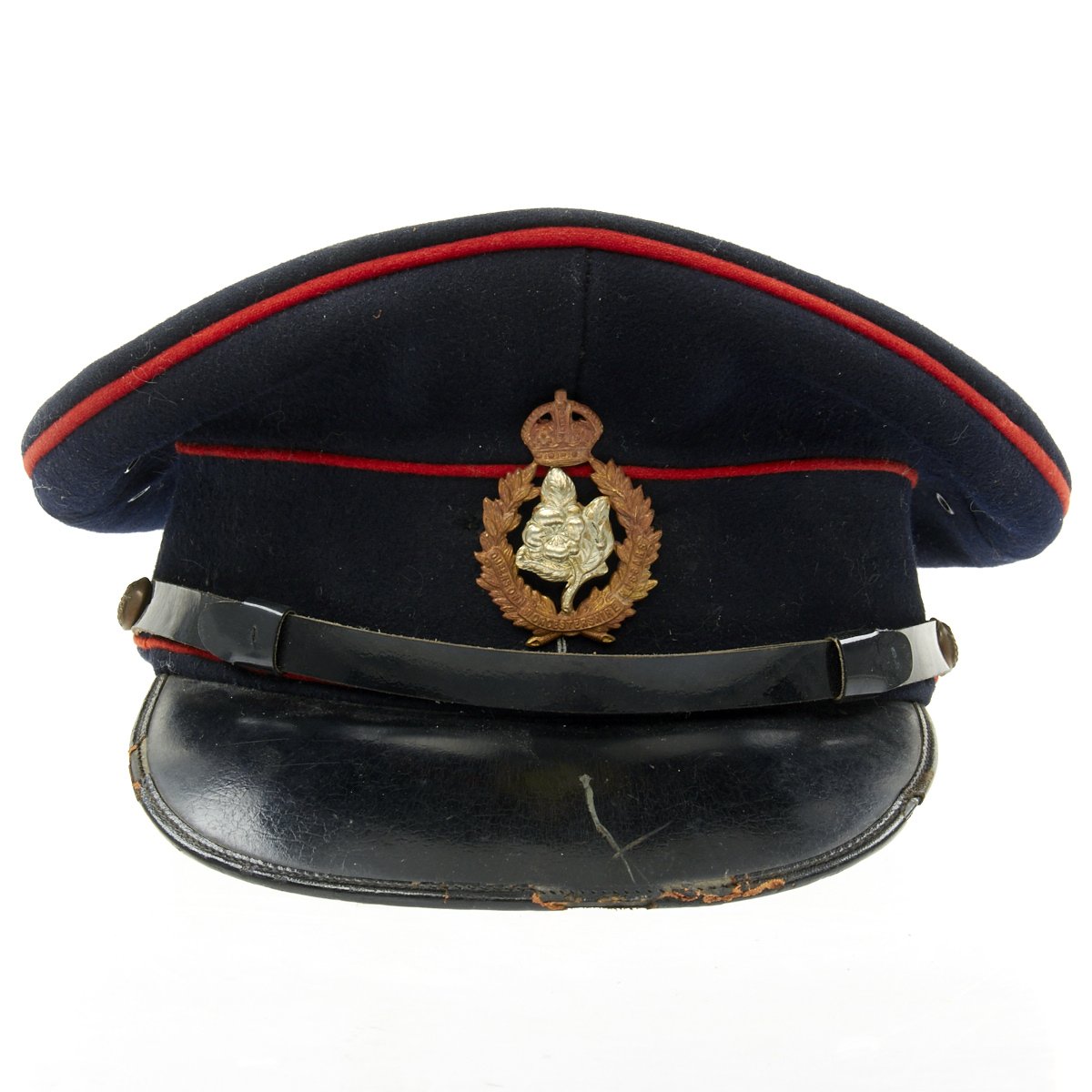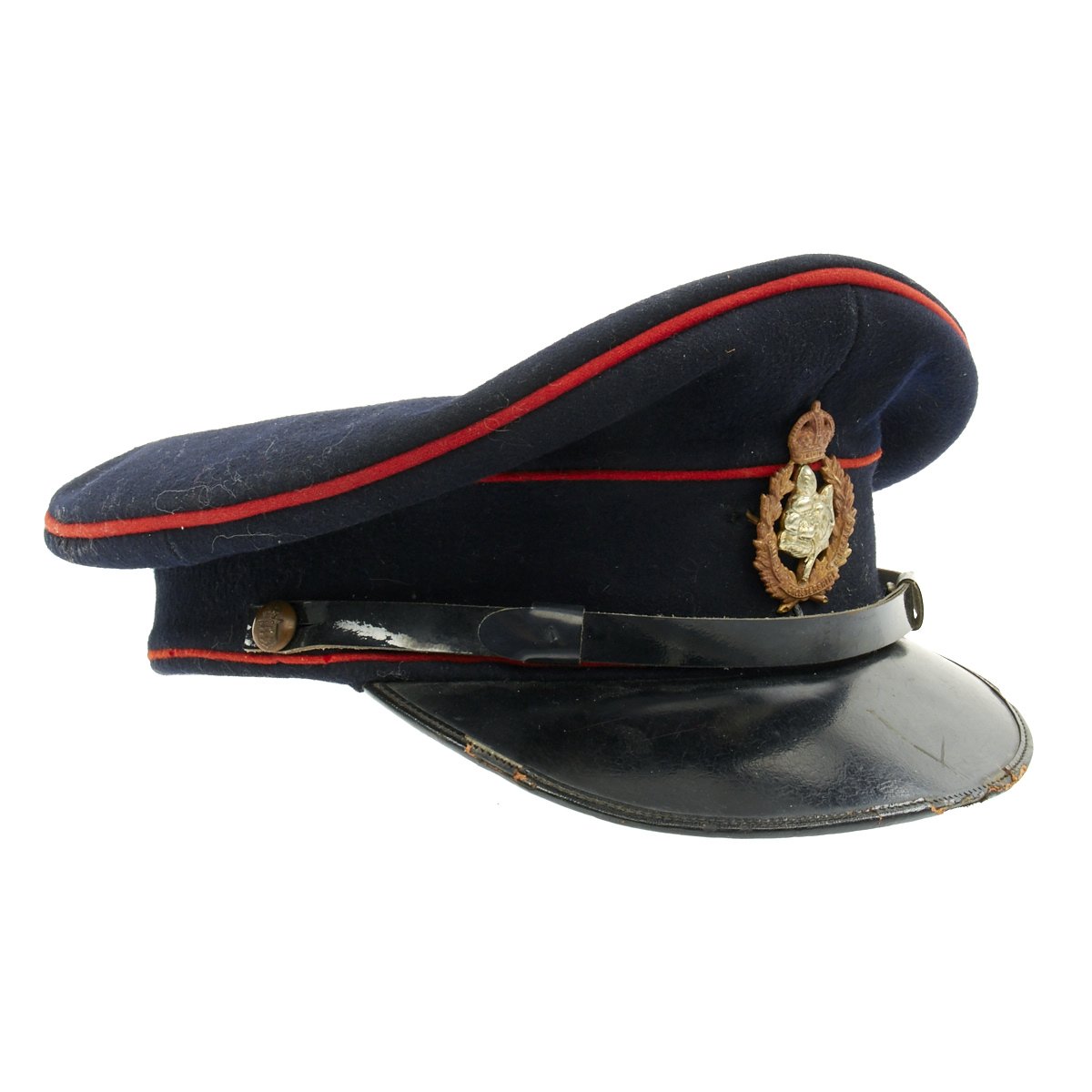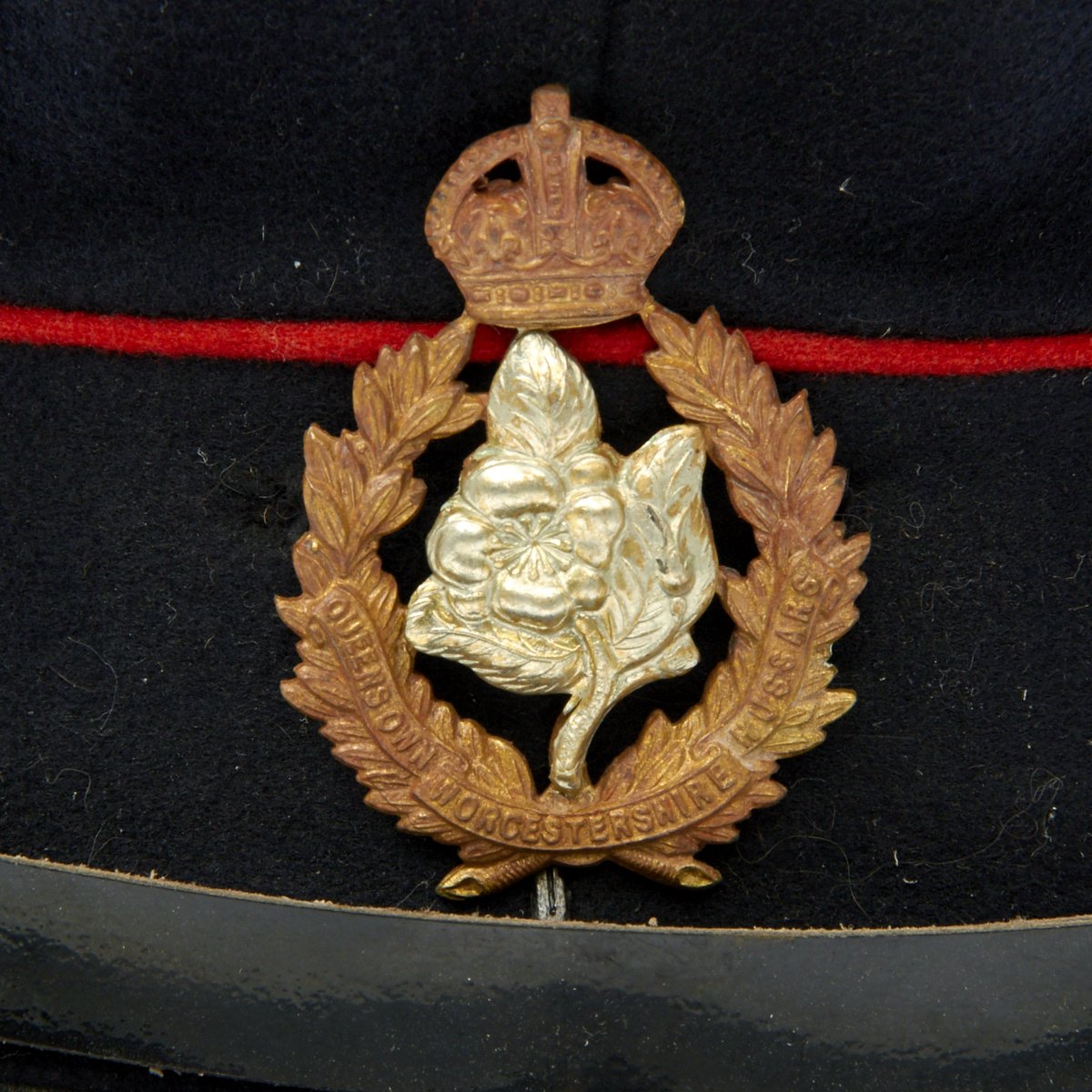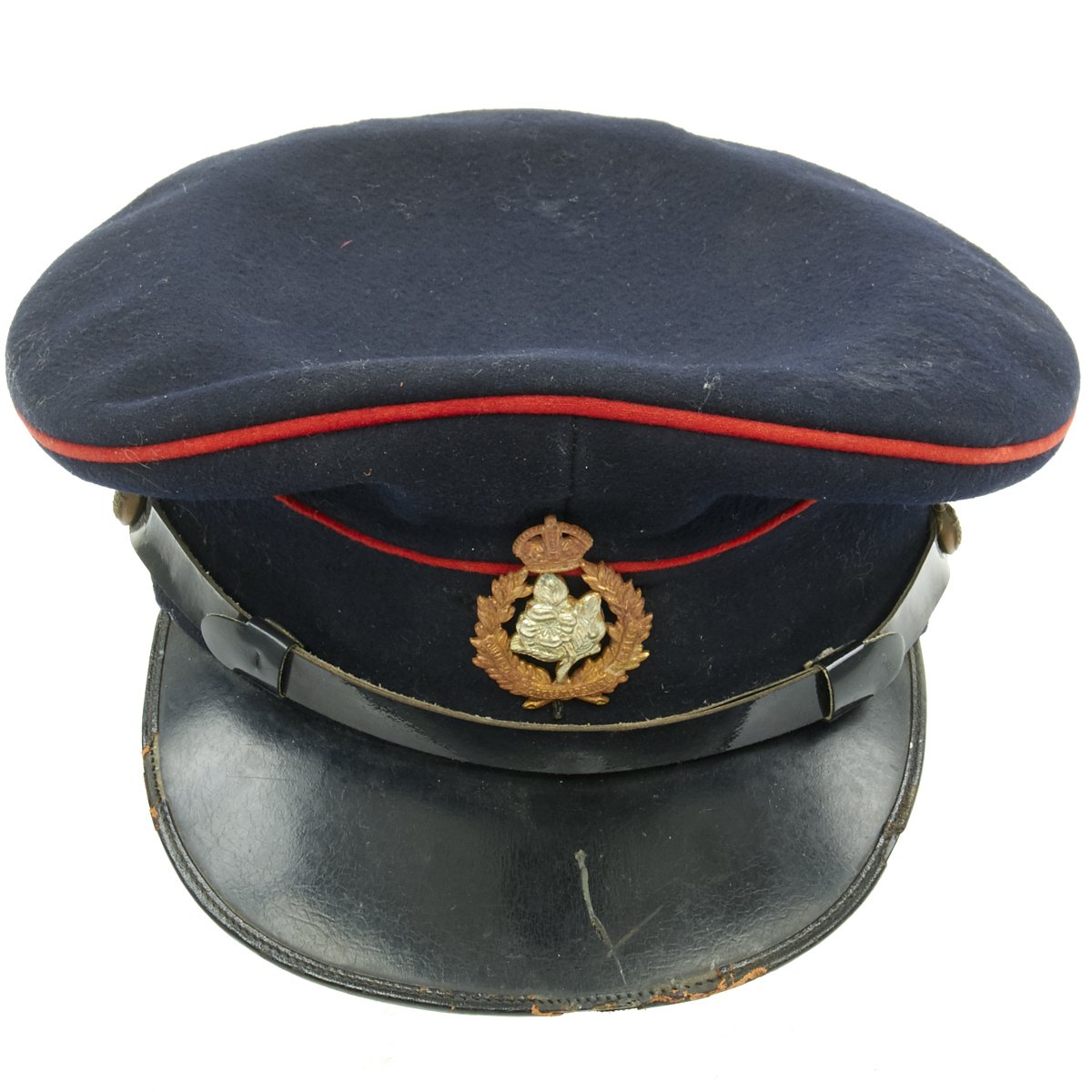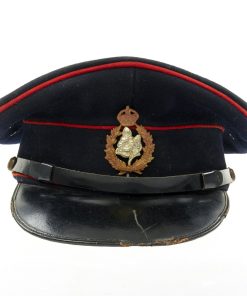Original British WWII Queens Own Worcestershire Hussars Officer Visor Cap Original Items
$ 175,00 $ 70,00
Original Item: Only One Available. This is a WW2 Artillery officer peaked visor cap for the Queens Own Worcestershire Hussars Regiment. The cap is offered in very good condition with the exterior constructed of dark blue wool with red piping (artillery), a patent leather visor and a wonderful Queens Own Worcestershire Hussars regimental hat badge. It has expected wear and aging and is approximately a size 7 US (56cm).
The Queen’s Own Worcestershire Hussars was a Yeomanry regiment of the British Army. First raised in 1794, it participated in the Second Boer War and World War I as horsed cavalry before being converted to an anti-tank regiment of the Royal Artillery for service in World War II.
The Regiment was part of the 48th (South Midland) Infantry Division and went with the division in January 1940 to join the British Expeditionary Force (BEF) on the border between France and Belgium. On 10 May 1940, the German Army’s attack started and the BEF moved forwards across the Belgian frontier to take position on the River Dyle. Lord Gort, commanding the entire BEF, was aware of the possibility of a northward retreat to the coast and used the 48th Division to cover the 28 miles of the La Bassee Canal.
Their purpose was to protect the western flank of the BEF by holding strongpoints such as canal crossings. Large enemy losses were inflicted by the 210 Battery together with troops of the 211 in support of the 2nd Battalion, Royal Warwickshire Regiment (of 144th Infantry Brigade) who were holding the town of Wormhoudt. These same troops were later involved in the Wormhoudt massacre.
Orders were received from Brigade to destroy their guns and vehicles and proceed to Dunkirk. Near Oost-Cappell the 212 Battery defended the crossroads against German tanks, some of which were destroyed, until being forced to withdraw after disabling their guns and vehicles. Each battery had been ordered to escape to Dunkirk, but only five officers and 284 men of the Regiment were evacuated from the beaches of Dunkirk in Operation Dynamo. The Regiment had, however, gained the distinction of having destroyed more enemy tanks than any other anti-tank Regiment of the BEF.
In October 1941 the regiment was transferred to 42nd (East Lancashire) Infantry Division, which was being converted into an armored division. 42nd Armored Division was broken up in October 1943, when the regiment moved to 6th Airborne Division, at first as an A/T regiment, then from 3 November as a light field regiment designated 53rd (Worcestershire Yeomanry) Air Landing Light Regiment, RA, and was now part of the British Army’s airborne forces.
D-Day
Owing to a shortage of gliders, only 211 Battery participated in the British airborne assault on D-Day, 6 June 1944. Together with the 6th Airborne Division, they were tasked to seize and hold the high wooded area behind the city of Caen, which would see very heavy fighting during the Battle for Caen in the weeks to come, on the eastern flank of the Normandy bridgehead. 211 Battery landed near Caen in 27 gliders on 6 June.
The Regiment’s other Batteries, 210 and 212, were sent to Normandy on Empire Capulet, which had been pressed into service as a troopship. They landed by sea at Luc-sur-Mer, on 14 June and joined up with 211 the following day; the complete Regiment going into action on 15 June. The Regiment now manned a series of Forward Observation Posts providing information for the Parachute and Commando Brigades against German mortar strongpoints. By 16 August, reports were received that the Germans were pulling out eastwards.
Major-General Richard Nelson Gale, General Officer Commanding the 6th Airborne Division, received orders that his command, together with the Regiment, was to maintain pressure on the retreating Germans on the coastal route towards the Seine in Operation Paddle. Progress was slow but the Regiment reached Honfleur on 27 August. They then returned to England to rest and reform for future airborne operations with the rest of the 6th Airborne Division.
On 20 December 1944, the Regiment received orders to embark for France again and by 26 December they were in action near Dinant in support of the 6th Airlanding Brigade, as the Americans and British defended against the German offensive in the Ardennes. The Regiment’s 210 Battery claimed to be the first to land shells over the frontier on German soil.
Operation Varsity
In March 1945, the plan for Operation Varsity was to drop two Airborne divisions (the British 6th and US 17th), including the Regiment, behind enemy lines north of Wesel, isolate the industrial Ruhr and disrupt the German rear defences. On 24 March, 78 gliders set off from England for a successful attack that established bridgeheads on the eastern bank of the Rhine.
The first guns were in action within 10 minutes of the gliders landing. By the evening, all of the divisions’ objectives had been taken but 2 Battery Commanders and 20 Other Ranks had been killed, with 8 officers and 59 men missing or prisoners of war. The advance continued and six weeks later they reached the Baltic coast.
The Regiment had fought in and captured the towns of Greven, Lengerich, Osnabrück, Minden and Lahder. Heavy German resistance was encountered near Celle on 15 April, when German self-propelled guns caused problems for 6th Airborne until they were outflanked after heavy shelling by the Regiment.[1] The advance of the Regiment met with the Russian Army westward advance on 30 April, on the Baltic Coast at Wismar.
Palestine
The Regiment had returned to England by 23 May and was then ordered in September 1945 to Palestine. Its task was to help establish and maintain security in the Jewish state against Arab hostility and internal Jewish battles for power. The Regiment retrained as infantry to act as a police force, controlling and searching traffic along the north to south roads into Jerusalem, Tel Aviv and Jaffa. Their largest operation was to search Tel Aviv in three days, arresting men suspected of subversive activities and discovering hidden dumps of arms.
Fast Shipping with Professional Packaging
Thanks to our longstanding association with UPS FedEx DHL, and other major international carriers, we are able to provide a range of shipping options. Our warehouse staff is expertly trained and will wrap your products according to our exact and precise specifications. Prior to shipping, your goods will be thoroughly examined and securely secured. We ship to thousands clients each day across multiple countries. This shows how we're dedicated to be the largest retailer on the internet. Warehouses and distribution centres can be located throughout Europe as well as the USA.
Note: Orders with more than one item will be assigned a processing date depending on the item.
Before shipping before shipping, we'll conduct a thorough inspection of the items you have ordered. Today, the majority of orders will be delivered within 48 hours. The delivery time will be between 3-7 days.
Returns
The stock is dynamic and we cannot completely manage it because multiple stakeholders are involved, including our factory and warehouse. So the actual stock may alter at any time. It's possible that you may not receive your order once the order has been made.
Our policy is valid for a period of 30 days. If you don't receive the product within 30 days, we are not able to issue a refund or an exchange.
You can only return an item if it is unused and in the same state as the day you received it. You must have the item in its original packaging.
Related products
Uncategorized
Uncategorized
Uncategorized
Armoured Fighting Vehicles of the World: AFVs of World War One (Hardcover Book) New Made Items
Uncategorized
Uncategorized
Uncategorized
Uncategorized
Uncategorized
Uncategorized
Uncategorized
Uncategorized
Uncategorized
Uncategorized
Uncategorized
Uncategorized
Uncategorized
